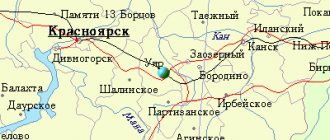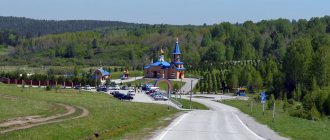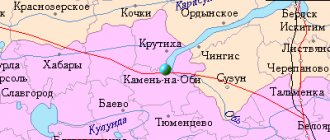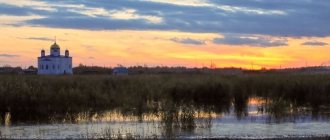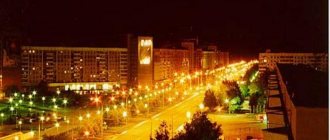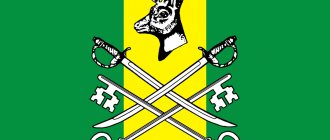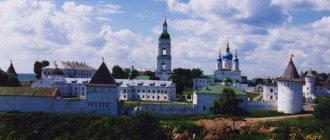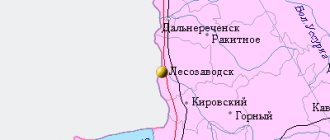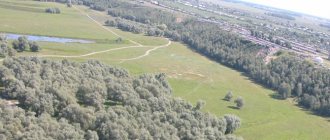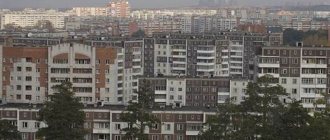If you were looking for other places with the same name, see Krasnokamensk (city district).
City in Zabaykalsky Krai, Russia
| Krasnokamensk Krasnokamensk | |
| City [1] | |
| Street in Krasnokamensk | |
| Flag Coat of arms | |
| Location Krasnokamensk | |
| Krasnokamensk Location Krasnokamensk Show map of Russia Krasnokamensk Krasnokamensk (Trans-Baikal Territory) Show map of Zabaykalsky Krai | |
| Coordinates: 50°06'N 118°02'E / 50.100°N Latitude 118.033°E / 50,100; 118.033 Coordinates: 50°06'N 118°02'E. / 50.100 ° N Latitude 118.033°E / 50,100; 118,033 | |
| A country | Russia |
| Federal subject | Transbaikal region [1] |
| Administrative region | Krasnokamensky district [1] |
| Based | 1968 |
| City status from | 1969 |
| Height | 640 m (2,100 ft) |
| Population (2010 Census) [2] | |
| • General | 55 666 |
| • Evaluate (2018) [3] | 52 299 ( -6% ) |
| • Classify | 295th place in 2010 |
| Administrative status | |
| • Capital from | Krasnokamensky district [1] |
| Municipal status | |
| • Municipal district | Krasnokamensky municipal district [4] |
| • Urban village | Urban settlement Krasnokamensk [4] |
| • Capital from | Krasnokamensky municipal district [5], urban settlement Krasnokamensk [6] |
| Timezone | UTC+9 (MSK+6[7]) |
| Postal code [8] | 674670, 674673, 674674, 674676, 674677, 674684 |
| Dialing code(s) | +7 30245 |
| OKTMO ID | 76621101001 |
| Web site | Krasno-Kamensk.rf |
Krasnokamensk
(Russian: Krasnokamensk, IPA: [krəsnɐkamʲɪnsk]) is a city and the administrative center of Krasnokamensky Okrug in Zabaykalsky Krai, Russia, located near the Sino-Russian border, 535 km (332 mi) southeast of Chita, the administrative center of the region. It is best known as the location of Russia's largest uranium mine. Population: 55,666 people (according to the 2010 census); [2] 55,920 (2002 census); [9]66,872 people (1989 census). [10]
Economics [edit]
The city is best known for its uranium mine, the Priargunsky mine, the largest in Russia, located 10–20 km [12] from Krasnokamensk. The Argunsky region represents one of the largest uranium reserves in Russia with estimated reserves of 71.9 million tons of ore with a 0.16% uranium content. [13]
The full name of the complex is the Priargunsky Mining and Chemical Production Association (PIMCU), which consists of uranium mines, processing plants and tailings ponds, as well as a lignite mine and power plant, as well as a manganese casting plant and a mill. [12]
In 1995, 5 million pounds of uranium were mined. [14] In 1996, it was reported that over the previous 17 years, 10 km of the creek bed had been contaminated with radiation levels of 170 microroentgen/hour, 10 times the global average. [14] In 1998, it was reported that 2,470 tons of uranium contained in the ore had been mined from the area, and that over 100,000 tons of uranium had been mined over the life of the mine. [15] In 1998 and 2002, it was reported that the site was the only active uranium mining site in Russia in previous decades. [12] In 2001, it was reported that the area was once the world's largest uranium mining and processing center, and in 2001 it was the fifth largest in the world.[16] In 2001, it was reported that the uranium deposit could be depleted by 2026. [16] The area produced 2,900 tons of uranium in 2006, making it the fourth largest producer with 7% of total global production. [17] [18]
Molybdenum is also mined in the area around the city, from associated chemical plants producing sulfuric acid and lubricants. [ citation needed
]
Pollution[edit]
According to the Blacksmith Institute, Krasnokamensk generated between fifty and seventy-five million tons of tailings, making it the largest waste stream from a uranium mining site in the world. Bailey's community survey documents hundreds of homes with radiation levels 10 to 20 times higher than acceptable levels. About 500–1,000 homes or more suffer from radiation exposure far in excess of international standards. [19]
In recent years, dangerously high levels of radioactivity have led to the evacuation and relocation of residents living near the tailings ponds.
Transport[edit]
Since 1972, the city has been connected by a railway line to the Russian railway network. Krasnokamensk is served by Krasnokamensk Airport.
Map of the city of Krasnokamensk. Krasnokamensk Yandex maps
Created using the Yandex service People's Map (Yandex map), when zoomed out you can understand the location of Krasnokamensk on the map of Russia. Krasnokamensk Yandex maps. Interactive Yandex map of the city of Krasnokamensk with street names, as well as house numbers. The map has all the symbols of Krasnokamensk, it is convenient and not difficult to use.
On the page you can read some descriptions of Krasnokamensk. You can also see the location of the city of Krasnokamensk on the Yandex map. Detailed with descriptions and labels of all city objects.
Share information with friends:
Climate[edit]
Krasnokamensk has a harsh boreal climate (according to the Köppen climate classification Dwc
).
It is influenced by monsoons and borders very closely on a humid continental climate ( Dwb
).
Summer is short but very warm (and humid). Winters are very long, very dry and very cold. Climate data for Krasnokamensk
| Month | Jan | Feb | Mar | Apr | Maybe | Jun | Jul | Aug | Sep | October | But I | December | Year |
| Average high °C (°F) | -20,4 (-4,7) | -15,5 (4,1) | -4,9 (23,2) | 8,0 (46,4) | 17,6 (63,7) | 24,1 (75,4) | 26,0 (78,8) | 23,3 (73,9) | 16,4 (61,5) | 6,7 (44,1) | -7,4 (18,7) | -17,8 (0,0) | 4,7 (40,4) |
| Daily average °C (°F) | -26,8 (-16,2) | -23,1 (-9,6) | -12,6 (9,3) | 1,0 (33,8) | 9,9 (49,8) | 16,7 (62,1) | 19,8 (67,6) | 17,1 (62,8) | 9,6 (49,3) | 0,0 (32,0) | -13,8 (7,2) | -23,7 (-10,7) | −2,2 (28,1) |
| Average low °C (°F) | -33,1 ( -27,6 ) | -30,6 (-23,1) | -20,2 (-4,4) | -6,0 (21,2) | 2,2 (36,0) | 9,4 (48,9) | 13,6 (56,5) | 10,9 (51,6) | 2,8 (37,0) | -6,7 (19,9) | -20,1 (-4,2) | -29,6 (-21,3) | -9,0 (15,9) |
| Average precipitation, mm (inches) | 2 (0,1) | 3 (0,1) | 4 (0,2) | 12 (0,5) | 21 (0,8) | 56 (2,2) | 107 (4,2) | 80 (3,1) | 39 (1,5) | 8 (0,3) | 4 (0,2) | 4 (0,2) | 340 (13,4) |
| Source: [20] | |||||||||||||
Links[edit]
- ^ abcde Register of administrative-territorial units and settlements of the Trans-Baikal Territory
- ^ a b Federal State Statistics Service (2011). All-Russian Population Census 2010. Volume 1 [All-Russian Population Census 2010, vol. 1]. All-Russian Population Census 2010 [All-Russian Population Census 2010] (in Russian). Federal State Statistics Service.
- "26. The size of the permanent population of the Russian Federation by municipalities as of January 1, 2022". Federal State Statistics Service. Retrieved January 23, 2022.
- ^ abc Law No. 317-ZZK
- Law No. 316-ZZK
- Federal State Statistics Service. Federal Agency for Technological Regulation and Metrology. No. OK 033-2013 January 1, 2014 “All-Russian classifier of municipal territories. Code 76 621 101.” (Federal State Statistics Service. Federal Agency for Technological Regulation and Metrology. No. OK 033-2013 dated January 1, 2014. Russian classification of municipal territories. Code 76 621 101.
). - "On the Calculation of Time". Official Internet portal of legal information
. June 3, 2011. Retrieved January 19, 2022. - Post office. Information and computing center of OASU RPO. ( Post office
).
Search for postal service objects ( postal Search for objects
) (in Russian) - ↑
Federal State Statistics Service of Russia (May 21, 2004). The population of the Russian Federation, cities of the Russian Federation as part of federal districts, urban settlements, settlements, settlements, settlements is 3 thousand or more people. [Population of Russia, its federal districts , subjects of the Federation, districts, urban settlements, rural settlements - administrative centers and rural settlements with a population of more than 3000 people] (XLS). All-Russian Population Census of 2002 [All-Russian Population Census of 2002] (in Russian). - All-Union Population Census of 1989 Population of Union and Autonomous Republics, Autonomous Regions and Districts, Territories, Regions, Urban Settlements and Village District Centers [All-Union Population Census of 1989: Current Population of Union and Autonomous Republics, Autonomous Regions and Districts, Territories, Regions , districts, urban settlements and villages performing the functions of district administrative centers]. All-Union Population Census of 1989 [All-Union Population Census of 1989] (in Russian). Institute of Demography of the National Research University: Higher School of Economics [Institute of Demography of the National Research University: Higher School of Economics]. 1989 - via Demoscope Weekly
. - Where is Khodorkovsky? — Report from Westdeutschen Rundfunk (German)
- ^ a b c Boytsov A.V. Nikolsky AL; Chernigov V.G.; Ovseychuk, V.A. (2002). Uranium mining and environmental restoration in the Argunsky center, Russian Federation (Report). International Atomic Energy Agency (IAEA). Retrieved December 19, 2020.
- "Russia's nuclear fuel cycle". world-nuclear.org. 2013. Retrieved July 5, 2013.
- ^ ab Robinson, Paul (Winter 1996–97). "Uranium mines of Siberia". Earth Island Magazine
. Vol. 12 hours 1. pp. 8–9. JSTOR 43882800. Retrieved December 19, 2020. CS1 maint: date format (link) - ↑
OECD/NEA (2000). Uranium 1999: Resources, Production and Demand (Report). Paris: OECD Publishing. DOI: 10.1787/9789264189898-en. - ^ ab Kaiser, Robert G. (August 8, 2001). "The Source of Uranium Mine Reality". Washington Post
. Retrieved December 19, 2022. - Kok, Kenneth D., ed. (2009). Handbook of Nuclear Engineering. CRC Press. item 259. ISBN. 9781420053913. Retrieved December 19, 2020.
- ↑
Belton, Katherine (January 12, 2006), "For Russia, dependence on 'man-made disaster'",
NY Times
, retrieved December 19, 2022. - https://www.blacksmithinstitute.org Blacksmith Institute Website
- https://en.climate-data.org/location/46066/ . Retrieved December 15, 2016. Missing or empty |title=( help )
- "Archival copy". Archived from the original on May 14, 2013. Retrieved October 31, 2012.CS1 maint: archived copy as title (link)
Sources [edit]
- Ministry of Territorial Development of the Trans-Baikal Territory. January 1, 2014 “Register of administrative-territorial units and settlements of the Trans-Baikal Territory,” ed. Decree No. 209-r dated June 10, 2014 (Ministry of Territorial Development of the Trans-Baikal Territory. January 1, 2014. Register of administrative-territorial units and settlements of the Trans-Baikal Territory
as amended by Decree No. 209-r dated June 10, 2014). - Legislation Assembly of the Trans-Baikal Territory. Law No. 317-ZZK of December 18, 2009 “On the boundaries of rural areas and urban settlements of the Trans-Baikal Territory”, as amended. Law No. 1070-ZZK of October 31, 2014 “On Amendments to the Law of the Trans-Baikal Territory” On the Borders of Rural Settlements of the Trans-Baikal Territory “”. Came into force ten days after the day of official publication. Published: “Trans-Baikal Worker”, No. 239–242, December 21, 2009 (Legislative Assembly of the Trans-Baikal Territory. Law No. 317-ZZK of December 18, 2009 “ On the boundaries of rural and urban settlements of the Trans-Baikal Territory”
as amended by Law No. 1070- LZK dated October 31, 2014 “
On Amendments to the Transbaikal Law”).
Region "On the border of rural and urban settlements of the Trans-Baikal Territory" . Valid from the day that occurs ten days after the day of official publication.). - Legislation Assembly of the Trans-Baikal Territory. Law No. 316-ZZK of December 18, 2009 “On the boundaries of municipal and urban districts of the Trans-Baikal Territory,” as amended. Law No. 770-ZZK of December 26, 2012 “On Amendments to the Law of the Trans-Baikal Territory.” Came into force ten days after the day of official publication. Published: “Trans-Baikal Worker”, No. 239–242, December 21, 2009 (Legislative Assembly of the Trans-Baikal Territory. Law No. 316-ZZK of December 18, 2009 “ On the boundaries of municipal districts and urban districts of the Trans-Baikal Territory”
as amended by Law No. 770 -ZZK dated December 26, 2012
On amendments to the Law of the Trans-Baikal Territory “On the boundaries of municipal districts and urban districts of the Trans-Baikal Territory"
. Valid from the day that occurs ten days after the day of official publication.).
Krasnokamensk // “Historical Encyclopedia of Siberia” (2009)
KRASNOKAMENSK , a city of regional subordination in the Trans-Baikal Territory, is located in the foothills of the Argun Range, 560 km by rail southeast of Chita.
Railway station, airport. Founded in 1968 as a village, in 1969 it received city status, and since 1977 it has been the administrative center of the Krasnokamensky district. Population (thousand people): 1970 - 13.8; 1979 - 50.6; 1989 - 66.8; 2002 - 55.9; 2007 - 55.6.
Krasnokamensk arose in connection with the discovery in 1963 and development of the Streltsovskoye uranium deposit. The city-forming enterprise is the Priargunsky Industrial Mining and Chemical Association, the only uranium mining enterprise in Russia, also engaged in coal mining (Urtuisky open-pit mine), thermal and electrical energy generation (CHP), repair of machinery and equipment (Krasnokamensky Mechanical Repair Plant), and sulfur production acid (sulfuric acid plant), building lime, etc. There are more than 30 municipal unitary enterprises in Krasnokamensk: “Avtotransportnoye”, “Municipal Pharmacy”, “Road and Communal Services”, “Housing and Communal Administration”, a bakery, a meat processing plant, a dairy plant and others. Since 1972, the railway line of the Trans-Baikal Railway began to operate. Social and cultural sphere: 8 secondary schools, a gymnasium, a school for children with mental retardation, 11 kindergartens, a children's music and choreography school, a children's art school, 2 vocational schools, a medical college, branches of the Chita Pedagogical and Angarsk Polytechnic Colleges, the Education Center youth (until 1994, a school for working youth), 2 cultural centers, a network of libraries, healthcare facilities, and sports facilities. There is a folk dance ensemble "Transbaikalians", an amateur theater "Kamerton", a museum of mineralogy, a monument to pioneers, a monument to Transbaikalians who died during the Great Patriotic War, an Orthodox church, and a chapel in the cemetery. The border location contributes to the development of cultural, trade and economic ties with the PRC.
The coat of arms was approved in 2000. The shield is divided into 4 parts by a narrow golden cross. In the first scarlet part there is a golden atom with electron orbits; in the 2nd and 3rd azure parts there is a golden sun; in the 4th scarlet part the date of the foundation of Krasnokamensk is indicated in gold. The green chapter has a golden one. inscription with the name of the city.
Lit.: All Russia. Cities and towns: Encyclopedia. M., 2001; Krasnokamensk JSC PIMCU. 35 years. Novosibirsk, 2003; Encyclopedia of Transbaikalia: Chita region. Novosibirsk, 2006. T. 3.
S.K. Patrina, A.P. Chechel
